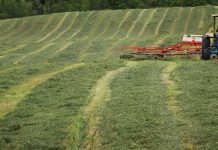In the 192 months that spanned between July 1991 and August 2006, U.S. corn traded under $3 per bushel in 171 of those months, peaking for only a short time at over $5 per bushel in May 1996. We thought then that this was really expensive corn.
Since September 2006, U.S. corn has not traded under $3/bushel — not one single time — and chances are good that we will never see corn under $3 per bushel ever again. Meanwhile, milk prices have played yo-yo like never before.
What is a dairy producer supposed to do in this new world of high feed prices and gyrating milk prices? How can margins be managed?
Because net margin from milk production is now so dependent on the difference between milk sales and feed costs, a focus on milk and feed prices serves as a good proxy to net margins.
On the feed costs side of the margin equation, there are a few things that producers can do:
Shop better
Finding the same feed, but cheaper somewhere else. Make sure, however, that you are comparing apples with apples. Commodities can have the same name, but different specifications.
The same is true for manufactured feeds, milk replacers, etc… Make use of cash discounts. First, you have to make sure that you have a sufficient cash flow, but some suppliers are offering very attractive cash discounts. A 1 or 2 percent discount for paying two weeks early equates to a 25 percent+ ARP on your money. Not bad when certificates of deposits over 3 percent APR are nearly impossible to find.
Don’t carry a balance on your credit cards. Even your obnoxious brother-in-law can lend you money at a lower rate than most credit cards…
Make sure that you are getting what you paid for. Hidden fees are sometimes added to feed prices. Ask what the super-duper ‘premix’ is supposed to contain. Although not in Ohio, I have seen some very deceiving pricing on premixes, especially in the last 20 months.
Shop wiser
The idea is to find underpriced feeds and to avoid overpriced ones. This is very different than finding cheap feed and avoiding expensive ones.
The OSU software Sesame (available at www.sesamesoft.com) can be of great help in this regard. For guidance, we also publish a column on Sesame results for Ohio in every issue of our state dairy newsletter (Buckeye Dairy News, available at http://dairy.osu.edu).
Avoid the black holes
It is very common to experience a 5 percent shrink during storage of commodities. Likewise, the dry matter shrinkage of silages (corn or hay crop) can be considerable, averaging 15 percent on most farms.
With $7/bushel corn, the corn plants standing in the field ready to be chopped are worth approximately $49 per short ton. Once we add the costs of harvesting, transportation from the field, packing, inoculant, and silo cover, the chopped silage as it begins fermentation has a cost of about $61/ton.
Therefore, the cost for 15 percent fermentation losses amounts to $9.15/ton. Reducing fermentation losses to 10 percent of the dry matter reduces the fermentation losses to $6.10/ton, which translates into net savings of $25/cow per year. This can be achieved by rapid and aggressive packing and covering of the silage with an effective air barrier (plastic cover) and an effective silage inoculant.
Don’t cut corners
With cheap corn, the cost of feeding a single TMR to the lactating herd was small. And management of a single TMR is so much easier than managing multiple lactating rations. But single TMR programs are very hard to justify in an era of expansive feeds.
Recommendations are: one lactation ration for herds of less than 100 cows, two lactation rations for herds of 100 to 300 cows, and three lactation rations for herds with more than 300 cows.
Increasing milk component yields (fat and protein) is one of the most effective ways that producers can affect net margins.
Manage better
Stop using feed additives to cover up your management flaws. Most feed additives can make sense at least sometimes, but maybe not all the times.
Minimize the welfare check
Dry cows and replacement heifers are welfare recipients; the lactating cows have to pay to support them. In a 100-cow herd, net margins per hundredweight of milk drop by 30 percent if the number of replacements per 100 lactating cows goes from 80 to 100.
Managing milk prices
On the revenue side of the equation, little progress will be made until producers realize that they make money on only about seven pounds of each 100 pounds of milk shipped.
Over the last five years, nearly 55 percent of the average income over feed costs has been from milk protein yield (around 3 percent of the milk in Holstein), 40 percent from milk fat yield (around 3.7 percent of the milk in Holstein), leaving only about 5 percent in total from the lactose (around 4.8 percent of the milk), ash (around 0.9 percent of the milk), and water (around 87.5 percent of the milk) combined.
Increasing milk component yields (fat and protein) is one of the most effective ways that producers can affect net margins.
(The author is an Extension dairy specialist at Ohio State University. Questions or comments can be sent in care of Farm and Dairy, P.O. Box 38, Salem, OH 44460.)












